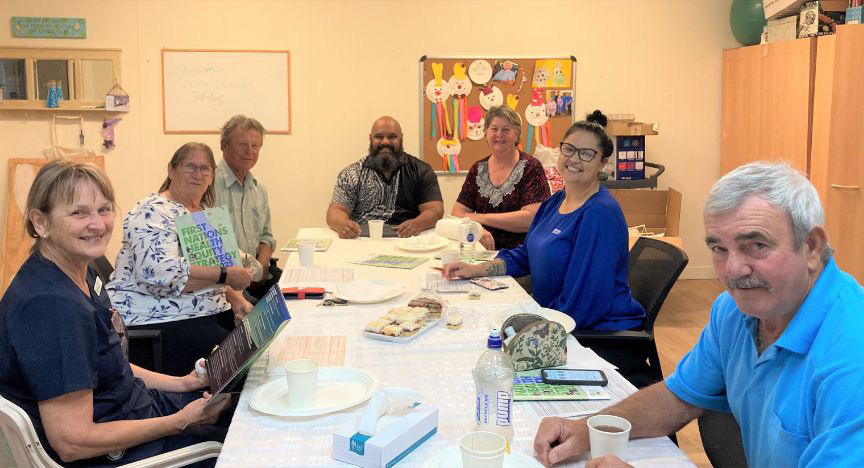
Tambo community briefing on First Nations Health Equity Strategy
A community meeting was held in Tambo on 22 November to discuss a historic document designed to improve the health outcomes for Aboriginal and Torres Strait Islander people in Central West Queensland.
The Central West Hospital and Health Service’s First Nations Health Equity Strategy was launched in Longreach on 8 November.
Following the launch of the strategy, Central West Health currently is undertaking consultation across the region on plans to implement the strategy.
Mr Carter said the implementation plan was an overarching guide that explained the priority actions of the First Nations Health Equity Strategy, the resources required to achieve the actions, timelines, and reporting functions.
Six community residents attended the Tambo implementation plan briefing session and all received a copy of the full First Nations Health Equity Strategy.
Central West Health Executive Director of Aboriginal and Torres Strait Islander Health Dan Carter said the Tambo participants in the community briefing had been very engaged.
“We worked collectively through the priorities and actions in the health equity strategy and captured some main themes from the meeting,’’ he said.
“For instance, participants thought reporting on progress in implementing the plan should be more frequent – possibly every three months rather than every six months – and this is something we will take away and consider.
“We also touched on how the community wanted to receive health and other important updates and were told that letter drops in Tambo have been very popular.
“We also discussed improved First Nations participation in local health facility Consumer Advisory Networks, ways to improve pathways into health careers and encouraging young people to consider a career in health, as well as greater participation by the local council.
“This was all valuable feedback and I’d like to thank community members in Tambo for attending the briefing and sharing their thoughts.’’
Mr Carter said the health service also gifted to the Tambo community a copy of the artwork that had been specially commissioned to illustrate the Central West First Nations Health Equity Strategy.
The artwork was produced by Tambo artists and proud Bidjara women Aunty Ann Russell and daughter Deann Frousheger.
Central West Hospital and Health Service Board Chair Jane Williams said the health service was dedicated to improving the health and wellbeing of our Aboriginal and Torres Strait Islander communities.
“To do this well, the health system must deliver culturally responsive, equitable and appropriate care, no matter where you live,’’ she said.
“It is completely unacceptable that Aboriginal and Torres Strait Islander people continue to die on average 10-12 years earlier than non-Indigenous people.
“This population is also more likely to have multiple illnesses, low birthweight babies, poor mental health, diabetes, and renal failure and are less likely to be immunised.
“We need to turn this around and that is what our new Health Equity Strategy is designed help us do.
"But achieving this requires much more than the provision of clinical services, it requires us to have an understanding and respect of cultural differences and needs, and a commitment to applying this understanding across all areas of the health service.’’
The Central West First Nations Health Equity Strategy focusses on six priority areas:
1. Improve First Nations health and well-being outcomes
2. Actively eliminate racial discrimination and institutional racism
3. Increase access to better health services
4. Deliver sustainable, culturally safe, and responsive healthcare services
5. Influence the social, cultural, and economic determinants of health
6. Work with First Nations peoples, communities, and organisations to design, deliver,
monitor, and review health services
Mr Carter said the Health Equity Strategy had been codesigned with the community, health professionals and other key stakeholders in the region.
“This strategy can only succeed if we harness the expertise and wisdom of our local community through ongoing meaningful engagement and consultation,” he said.
“As we progress now towards implementing the strategy, we are continuing to consult widely across all our communities, as we have done here in Tambo. We will continue engaging with all our communities as we move forward.
“Closing the Gap is not something that can be done by the public health system alone because the reasons for poor life-expectancy are complex. Community backing is vital to achieving better health outcomes.
“We are strongly committed to improving our services for Aboriginal and Torres Strait Islander residents and to delivering them in culturally appropriate ways.
“About eight per cent of our residents in the Central West, identify as Aboriginal or Torres Strait Islanders, with the greatest proportion amongst people aged up to 14 years.
“Given the young age of many of our Aboriginal and Torres Strait Islander residents, we also must be able to resonate with and connect with young people, quite separately from older First Nations men and women.
“Communicating appropriately and effectively with this younger demographic is one of the priorities of our new health equity strategy.’’
The full strategy can be accessed here.
NOTE
A local artwork created especially for the document by Tambo artists and proud Bidjara women Aunty Ann Russell and daughter Deann Frousheger provides a common illustrative thread throughout the Central West Health Equity Strategy. The artwork, Coming Together, tells a story that links the delivery of health services with First Nations culture.
The artwork shows the fine line connection that runs between the local communities linked by the local river system and the medical professionals that visit the region. The meeting places connected together in the artwork represent the towns in the Central West district – all linked with the river system. The handprints represent the local services that are in the communities, while the footprints represent the visiting health professionals that come to the communities. The animal prints are emu, kangaroo, and echidna tracks, while the border represents the continued communication between all the Central West communities.